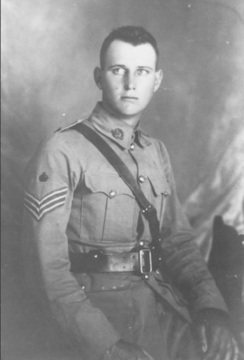IPKENDANZ, Robert Louis
| Service Number: | 491 |
|---|---|
| Enlisted: | 9 October 1914 |
| Last Rank: | Sergeant |
| Last Unit: | 7th Light Horse Regiment |
| Born: | Dulwich Hill, New South Wales, Australia, 1 March 1893 |
| Home Town: | Tambar Springs, Gunnedah, New South Wales |
| Schooling: | Fort Street High School, Sydney, New South Wales, Australia |
| Occupation: | Woolclasser, grazier |
| Died: | Cancer, Watsons Bay, New South Wales, Australia, 5 February 1948, aged 54 years |
| Cemetery: |
Springwood General Cemetery, New South Wales |
| Memorials: | Baradine Honour Roll WW1, Burwood Memorial Arch |
World War 1 Service
| 9 Oct 1914: | Enlisted AIF WW1, Sergeant, 491, 7th Light Horse Regiment | |
|---|---|---|
| 19 Dec 1914: | Involvement Sergeant, 491, 7th Light Horse Regiment, --- :embarkation_roll: roll_number: '2' embarkation_place: Sydney embarkation_ship: HMAT Ajana embarkation_ship_number: A31 public_note: '' | |
| 19 Dec 1914: | Embarked Sergeant, 491, 7th Light Horse Regiment, HMAT Ajana, Sydney |
Robert Louis Ipkendanz
Robert Louis IPKENDANZ, was born at Dulwich Hill, NSW on 1 March 1893 to parents William Louis Ipkendanz and Lina Ipkendanz (nee’ Probst), the fourth of seven children. Robert attended primary school at Springwood, New South Wales and later attended Fort Street High School in Sydney. In 1908 Robert enrolled at the Sydney Technical College to undertake classes in book-keeping, wool classing and mechanics. At the age of 17 or 18 Robert was employed as a jackaroo working on a sheep station in Queensland and, until his enlistment in the Australian Imperial Force (AIF), he worked on several larger sheep stations as wool classer and book keeper in Queensland and New South Wales.
Robert enlisted in the (AIF) at Coonamble on 9 October 1914 at the age of 21 and was posted to the 7th Light Horse Regiment, C Squadron, a new Regiment together with the 5th and 6th Regiments, which formed the new 2nd Light Horse Brigade. Posted as a Trooper on enlistment, Robert was promoted to Sergeant on 9 December 1914. The Regiment embarked from Sydney for Egypt on the troopship Ajana on 19 December 1914.
The Regiment disembarked at Alexandria, Egypt on 1 February 1915 and moved by train to Cairo where they were required to walk the 8 miles to their camp at Maadi. Robert and his Regiment landed at Gallipoli on 6 August 1915 and for most of August and into early September the Regiment was rotated to garrison positions including Lone Pine. During this time the unit diaries regularly referred to the health of the troops as “very bad”. On 9 September 1915 Robert’s C Squadron were posted to garrison trenches at Holly Spur. On 20 September 1915 Robert was transferred to the hospital ship Guildford Castle anchored off the Gallipoli coast, suffering from enteric fever. His condition did not improve while on the hospital ship, and he was then transferred to Alexandria and then via a hospital train to an enteric hospital at Cairo on 9 October 1915. On 2 November 1915 Robert was relocated to a convalescent camp at Port Said. With his condition still not improving, on 15 November 1915 Robert was transferred to the hospital ship Borda which embarked for Australia the same day. On arrival in Australia Robert was admitted to a repatriation hospital in Melbourne where he remained until 15 September 1916 when he was discharged as medically unfit.
After discharge Robert was successful in applying for a lease of land under the Soldier Settlement Scheme established in 1916. This lease was farmed until 1923 when it was sold and a larger area purchased nearby at Tambar Springs where he raised his family.
Robert died in Sydney on 5 February 1948 after a long illness.
Submitted 13 March 2025 by Peter Ipkendanz











